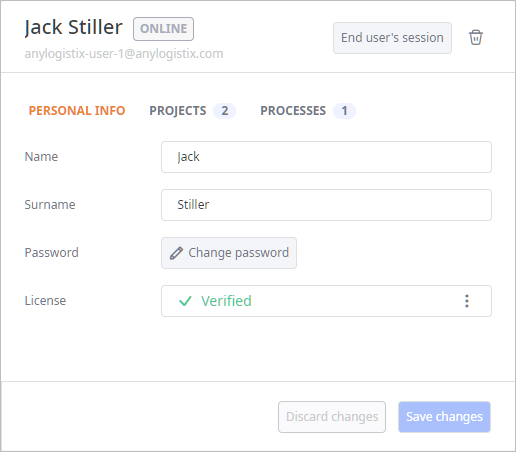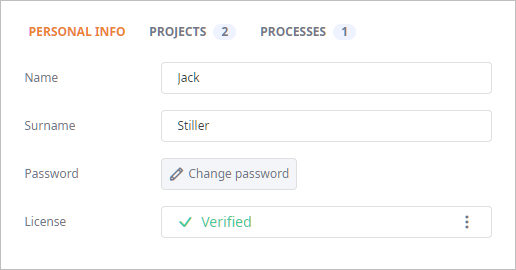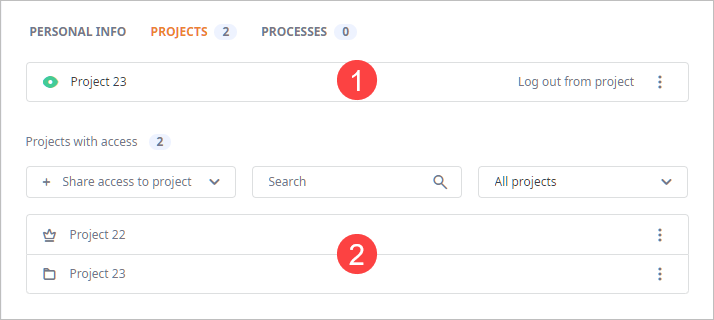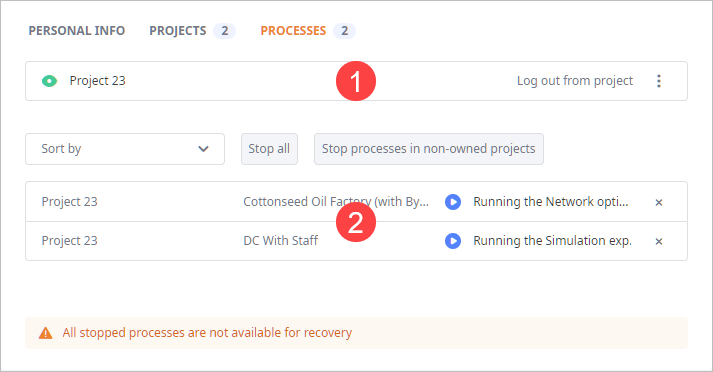This section is available in the administrator's Control Panel only.
In this section you manage users of your team.
anyLogistix desktop version is a single-user application, while the Professional Server is a multi-user application.
anyLogistix users may open their personal data section only.
To open the USERS section
- Log in as administrator. The Control Panel will open.
-
Click the USERS tab.
The USERS section will open.

The USERS section comprises:
-
The toolbar with the navigation tabs, and the
 button to create a new user.
button to create a new user.
- The left panel contains a list of all users organized in tiles, and controls for searching, sorting, and filtering the list.
- The right panel contains the profile of the user selected in the left panel.
The header of the left panel contains the following controls:

- Search — type any keyword to find the tiles containing it.
- Sort — sort user tiles in the ascending or descending order.
- Online users only — [disabled by default] enable to show online (logged in) users only.
The body of the left panel contains user tiles that show the following data per user:

- Tile title — contains the name of the user the tile belongs to.
- License — shows if a license is assigned to this user (Verified status) or not (No license).
- Projects — shows the number of projects this user has access to.
- In project — shows the name of the project this user is currently occupying.
The right panel contains the data and processes of the user selected in the left panel.

The profile comprises:
- The header with:
-
The body of the section with:
- PERSONAL INFO — [open by default] the user's personal info and password.
- PROJECTS — the projects this user has access to.
- PROCESSES — the processes started by this user.
This section contains the following user details:
Learn how to open administrator's profile

- Name — the name of the user.
- Surname — the surname of the user.
- Password — click the Change password button to change the user's password.
-
License — the license of the user. If the license is assigned, it says Verified.
Otherwise, you will see the available license counter and the Assign license button, allowing you to
assign license.
The
 Actions menu:
Actions menu:-
 Open license details — opens the LICENSE tab with the required
license selected.
Its details are available in the license profile on the right.
Open license details — opens the LICENSE tab with the required
license selected.
Its details are available in the license profile on the right.
-
 Revoke license — click to revoke license.
Revoke license — click to revoke license.
-
This section contains projects this user has access to.

- The project tile a user is currently occupying.
- Projects with access — the list of projects this user has access to and the controls to manage the list.
- The name of the occupied project.
- Log out from project — click to log out the user from this project.
-
 Actions — the actions menu, allowing you to navigate to the occupied project's
profile.
Actions — the actions menu, allowing you to navigate to the occupied project's
profile.
-
 Open project details — click to open the occupied project's profile.
Open project details — click to open the occupied project's profile.
-
 Cancel ownership — [available if the user is an owner of this project]
select to cancel this user's ownership in this project.
Cancel ownership — [available if the user is an owner of this project]
select to cancel this user's ownership in this project.
-
 Assign as owner — [available if the user is not an owner of this project] select to
assign this user as the owner for this project.
Assign as owner — [available if the user is not an owner of this project] select to
assign this user as the owner for this project.
-
 Revoke access — click to ban this user from this project.
Revoke access — click to ban this user from this project.
-
-
Control for managing the list of available projects:
- Share access to project — use the drop-down list to share access to the required projects.
- Search — use search to filter the list of projects the user has access to.
-
Filter the list of projects by the type of this user's rights:
- All projects — the list shows all projects the user can access.
- Projects with ownership — the list shows only projects where this user is an owner.
- Projects with granted access — the list shows only projects this user was granted access to.
-
The list of projects the user has access to. The list is sorted in alphabetical order and is grouped by user rights:
-
 Ownership
Ownership
-
 No ownership
No ownership
-
-
 Actions — use the actions menu to:
Actions — use the actions menu to:
-
 Open project details — click to open the project's profile.
Open project details — click to open the project's profile.
-
 Assign as owner — [available if the user is not an owner of this project] select to
assign this user as the owner for this project.
Assign as owner — [available if the user is not an owner of this project] select to
assign this user as the owner for this project.
-
 Cancel ownership — [available if the user is an owner of this project]
select to revoke this user's ownership in this project.
Cancel ownership — [available if the user is an owner of this project]
select to revoke this user's ownership in this project.
-
 Revoke access — click to ban this user from this project.
Revoke access — click to ban this user from this project.
-
This section contains all running processes started by this user in all projects this user has access to.

The section comprises:
- The project tile a user is currently occupying.
- list of started processes — the list of processes this user has started in all projects that were shared with this user.
- The name of the occupied project.
- Log out from project — click to log out the user from this project.
-
 Actions — the actions menu, allowing you to navigate to the occupied project's profile.
Actions — the actions menu, allowing you to navigate to the occupied project's profile.
- Open project details — click to open the occupied project's profile.
-
Controls for managing the list of running processes:
-
Sort by — use the drop-down list to sort the list of processes by:
- Project name from A to Z — the default project sorting type.
- Project name from Z to A
- Scenario name from A to Z
- Scenario name from Z to A
- Process name from A to Z
- Process name from Z to A
- Stop all — click to stop all processes started by this user.
- Stop processes in non-owned projects — click to stop only processes this user started as a guest in projects created by other users.
-
Sort by — use the drop-down list to sort the list of processes by:
-
The list of processes. The data is organized in table with each record showing data per running process:
-
The name of the project, in which the process is running.
The
 icon is shown before the project name if this user is the project owner.
icon is shown before the project name if this user is the project owner.
- The name of the scenario, in which the process is running.
- The status and the name of the running process
-
The
 button stopping the current process.
button stopping the current process.
If you stop a process, it will be terminated. You cannot pause it this way, which means that a stopped process cannot be started again from the Control Panel.
-
The name of the project, in which the process is running.
The
-
How can we improve this article?
-

